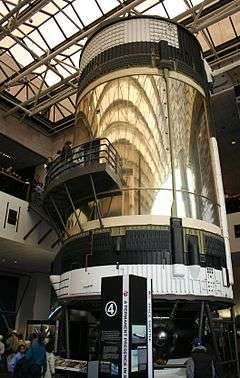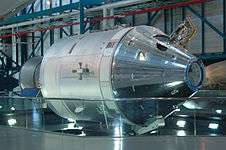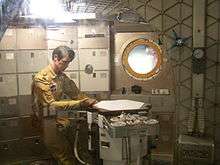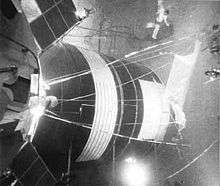Skylab B
 Skylab B Orbital Workshop at the National Air and Space Museum | |
| Station statistics | |
|---|---|
| Call sign | Skylab B, International Skylab, Advanced Skylab |
| Crew | 3 |
| Launch | canceled (currently at the National Air and Space Museum in Washington D.C.) |
| Mass | 77,088 kg |
| Height | 58 feet 5 inches (17.81 m) |
| Diameter | 21 feet 8 inches (6.60 m) |
| Days occupied | planned 56 to 90 days |
Skylab B was a proposed second US space station similar to Skylab that was planned to be launched by NASA for different purposes,[1][2] mostly involving the Apollo–Soyuz Test Project, but was canceled due to lack of funding. Two Skylab modules were built in 1970 by McDonnell Douglas for the Skylab program, originally the Apollo Applications Program. The first was launched in 1973 and the other put in storage, while NASA considered how to use the remaining assets from Apollo.
One considered option was to use Saturn V SA-515 to launch the backup Skylab station into orbit sometime between January 1975 and April 1976.[3] That way, it could expand the Apollo-Soyuz mission by 56–90 days.
Further proposals were made for an International Skylab, launched using Saturn V SA-514. This station would have been serviced by Apollo, Soyuz and later by the Space Shuttle.[4]
Potential uses
Some uses considered for the second Skylab module included putting it into a rotation mode where it could generate artificial gravity and a plan to celebrate the 1976 United States Bicentennial with the launch of two Soviet Soyuz missions to the back-up Skylab.
When the Apollo–Soyuz Test Project was created in 1972, NASA had also considered launching the back-up Skylab station during the ASTP mission in 1975, which would involve the Apollo spacecraft docking with the Soyuz spacecraft first, performing intended operations, then heading for the Skylab B, which during the ASTP discussion was originally called the International Skylab, for a 56–90 days extended mission.
Actually the earlier suggestion by McDonnell Douglas was to achieve a massive station by combining Salyut 1 with Skylab B. This would be achieved by launching an Apollo with a multiple docking adapter with 4 docking ports to be able to dock both stations and a both servicing vehicles (Soyuz and Apollo).[5]
For future missions, the station, which would have then been called the Advanced Skylab, could have been expanded by the Space Shuttle, which was due to enter service in 1979. At the time (1973) the idea was discussed, NASA still had two Saturn V launchers (SA-514 and SA-515), three Saturn IB boosters (SA-209, SA-210, SA-211), the back-up Skylab space station (Skylab B), three Apollo CSMs (CSM-117, CSM-118 and CSM-119) and two Lunar Modules in storage (LM-13, LM-14).
However, after the first Skylab was launched in May 1973, the plan for the Skylab B was canceled and the Apollo/Soyuz spacecraft had to use the Docking Module launched on the Apollo-Saturn IB for performing experiments in space. After Project Apollo ended and as NASA was moving to developing the Space Shuttle, the remaining Apollo hardware was donated to museums in 1976.
Possible crew
It was expected at the time by those involved that the initial crew would be the crew which served as backup for Skylab 3 and Skylab 4, and was kept in reserve for the Skylab Rescue mission (minus the science pilot):[6]
| Position | Astronaut | |
|---|---|---|
| Commander | Vance D. Brand | |
| Science Pilot | William Lenoir | |
| Pilot | Don L. Lind | |
Existing hardware
Apollo CSM
The Apollo Command Module CSM-119 was originally used for Skylab Rescue.
 CSM-119 on display at Kennedy Space Center
CSM-119 on display at Kennedy Space Center
Saturn IB
Saturn IB SA-209 was originally used for Skylab Rescue. Saturn IB SA-211 was unused.
 Saturn IB (SA-209) at the Kennedy Space Center Visitor Complex
Saturn IB (SA-209) at the Kennedy Space Center Visitor Complex Saturn IB (SA-211) at the Ardmore Welcome Center
Saturn IB (SA-211) at the Ardmore Welcome Center
Saturn V
The Saturn V SA-514 was originally designated for canceled Apollo 19.
- First stage (S-IC-14) on display at Johnson Space Center, second and third stages (S-II-14, S-IV-14) on display at Kennedy Space Center.
- The S-II interstage is located at Parque de las Ciencias[7]
- S-IC-14 on display at Johnson Space Center
_(2).jpg) S-II-14 on display at Kennedy Space Center
S-II-14 on display at Kennedy Space Center- S-IV-14 on display at Kennedy Space Center
Saturn V SA-515 was originally designated for Apollo 20, later as a backup Skylab launch vehicle.
- The first stage (S-II-15) is on display at Michoud Assembly Facility.
- The second stage (S-II-15) is on display at Johnson Space Center.
- The third stage is the Skylab B Orbital Workshop on display at the National Air and Space Museum. On display in the Museum's Space Hall since 1976, the orbital workshop has been slightly modified to permit viewers to walk through the living quarters.[8][9]
- S-IC-15 on display at Michoud Assembly Facility
- S-II-15 on display at Johnson Space Center
 Skylab B Orbital Workshop at the National Air and Space Museum
Skylab B Orbital Workshop at the National Air and Space Museum The waste management facilities in Skylab B at the National Air and Space Museum.
The waste management facilities in Skylab B at the National Air and Space Museum. A mannequin astronaut models dining aboard the Skylab B at the Smithsonian NASM.
A mannequin astronaut models dining aboard the Skylab B at the Smithsonian NASM.
Airlock Module
An Airlock Module is on display at the Evergreen Aviation & Space Museum.
_(5).jpg) Skylab Airdock Module in the Evergreen Aviation & Space Museum
Skylab Airdock Module in the Evergreen Aviation & Space Museum
Training mockups
A full-size mockup once used for astronaut training is located at the Lyndon B. Johnson Space Center visitor's center in Houston, Texas.
Another full-size training mockup is at the U.S. Space & Rocket Center in Huntsville, Alabama. Originally displayed indoors, it was subsequently stored outdoors for several years to make room for other exhibits. To mark the 40th anniversary of the Skylab program, the Orbital Workshop portion of the trainer was restored and moved into the Davidson Center in 2013.[10][11]
 Original trainer at the Neutral Buoyancy Laboratory, before display at the US Space & Rocket Center
Original trainer at the Neutral Buoyancy Laboratory, before display at the US Space & Rocket Center
Multiple Docking Adapter
Multiple Docking Adapter is on display at the Kennedy Space Center Visitor Complex.
- Multiple Docking Adapter at Kennedy Space Center Visitor Complex
References
![]()
- ↑ https://books.google.pt/books?id=X4WaYqQDVKwC&pg=PA301&lpg=PA301&dq=Skylab+B+was+a+proposed&source=bl&ots=Rpmh4dQn_q&sig=utFfCCjHCn623QW0SjyzjEFYblY&hl=pt-PT&sa=X&ved=0ahUKEwjj5f3E5rHPAhXBthQKHYB8BQwQ6AEIQzAD#v=onepage&q=Skylab%20B%20was%20a%20proposed&f=false
- ↑ https://books.google.pt/books?id=nL3lLGtc9mgC&pg=PA275&lpg=PA275&dq=Skylab+B+was+a+proposed&source=bl&ots=J6RBYXM7Z_&sig=Yejp_rfYafEYDoltHLnKDYaNp4U&hl=pt-PT&sa=X&ved=0ahUKEwjj5f3E5rHPAhXBthQKHYB8BQwQ6AEIbjAJ#v=onepage&q=Skylab%20B%20was%20a%20proposed&f=false
- ↑ http://www.astronautix.com/s/skylabb.html
- ↑ http://www.astronautix.com/s/skylabb.html
- ↑ Skylab Salyut Space Laboratory (1972)
- ↑ Lind, Don L.; Wright, Rebecca (May 27, 2005). Oral History Transcript, Johnson Space Center Oral History Project (PDF). Washington D.C.: NASA. p. 10. Retrieved June 21, 2016.
- ↑ http://www.americanspacecraft.com/pages/booster/sv-pr.html
- ↑ "Orbital Workshop, Skylab, Backup Flight Unit". Smithsonian Institution National Air and Space Museum.
- ↑ http://www.americanspacecraft.com/pages/skylab/index.html
- ↑ "Museum Galleries". Archived from the original on October 29, 2013.
- ↑ "Skylab Engineering Mockup Moves into Saturn V Hall at Space and Rocket Center After 10 Years Outdoors". AL.com.
- Frieling, Thomas J, Quest, "Skylab B: Unflown Missions, Lost Opportunities", 1996, Volume 5, Issue 4, page 12.

